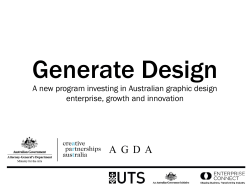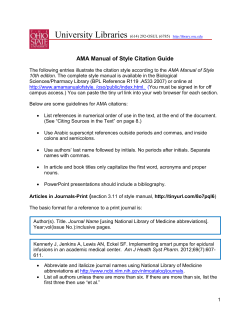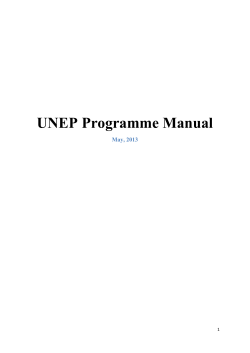
Sheng Fulai A Green Economy: Conceptual Issues
A Green Economy: Conceptual Issues Sheng Fulai Introduction The concept of a green economy has gained currency over the last year as the world has been searching for solutions to multiple global challenges. But this concept and its relationships with other related concepts has not been clearly articulated. This has invited repeated questions on exactly what is meant by a green economy even from people who have in principle embraced the concept. This lack of clarity has also brought into question whether this is yet another device to limit the space for developing countries to achieve development and poverty reduction. This paper using readily available information on the web is intended to facilitate a discussion rather than have the final word on conceptual issues related to a green economy. Green and Economy The word green in whichever language must have first come from human‟s observation of nature. In old times, our ancestors saw the colour green wherever they cast their sight: green forests, green mountains, and green waters (reflecting the surrounding greenness). This is probably why green has been used as synonyms of “natural”, “environmental”, “environmentally friendly”, or “ecological”. Some groups have also used the green colour as a symbol for both environmental protection and social justice (such as green parties in many European countries).1 The English word economy is often said to have originated from an ancient Greek word that is related to household management. The modern sense of the world according to one interpretation, however, is "the economic system of a country or an area". 2 In a number of East Asian countries, this modern western concept of economy was translated by Japanese scholars in the 17th century using a Chinese noun that consists of two verbs whose ancient meaning was “to govern (a society)” and “provide (for its people)”.3 An economic system is one in which various types of resources are used by economic agents to produce, trade, and distribute goods and services – material and spiritual – for human consumption.4 Human welfare or wellbeing is or should be the ultimate aim of efforts to govern and manage any economic system. At the operational level, however, such efforts typically seek to maximize the provision of goods and services with minimum price instability. The relationship between human wellbeing (often considered as being highly subjective) and the amount and type of available goods and services for consumption is left for individuals, households, and other economic agents to determine. Traditional economic models of the relationship assume that “more is better”. Two Faces of a Green Economy A green economy is typically understood as an economic system that is compatible with the natural environment, is environmentally friendly, is ecological, and for many groups, is also socially just. These attributes are the conditions that must be imposed on an economy from the perspective of many green economy advocates. This conventional concept of a green economy may be alternatively described as “the greening of an economy”. Some fundamental criteria for meeting these conditions have been established since Rio, such as using renewable resources within their regenerative capacity, making up for the loss of non-renewable resources by creating their The author is a staff member of the United Nations Environment Programme (UNEP). The author is grateful to Charles Arden-Clarke, Ivar Baste, Khalida Bouzar, Derek Eaton, Aniket Ghai, Arab Hoballah, Juhern Kim, Sylvie Lemmet, and Genevieve Verbrugge for their review and comments. Views expressed in this paper do not necessarily reflect the official positions of UNEP. 1 renewable substitutes, limiting pollution within the sink functions of nature, and maintaining ecosystem stability and resilience5 Conditions for social justice may include: 1) not compromising future generations‟ capability to meet their needs; 2) the rights of poor countries and poor people to development and the obligations of rich countries and rich people to changing their excessive consumption levels; 3) equal treatment of women in access to resources and opportunities; and 4) ensuring decent labour conditions. Additionally, issues of good governance and democracy are also seen as critical for ensuring social justice and equity. Less understood but should be of a much greater interest is a green economy as an economic system that is dominated by investing in, producing, trading, distributing, and consuming not only environmentally friendly6 but also environmentally enhancing7 products and services. In this sense, many green conditions such as those listed above should no longer be seen as constraints on an economy; instead, they should be regarded as forces that generate new economic opportunities. This is about expanding and reshaping, not reducing, the space for economic development and poverty reduction. The way this modern concept of a green economy is described above seems consistent with the way in which other major types of an economy are described: 1) an agrarian economy (“an economy which relies on farming.”)8; 2) an industrial economy (“an economy dominated by manufactured goods”)9; 3) a service economy (“an economy dominated by services rather than products”)10; and 4) a knowledge economy (an economy “based on the production, distribution, and use of Knowledge as the main driver of growth, wealth creation, and employment across all industries”)11. Similarly, a green economy is one dominated and driven by the demand for, and supply of, environmentally friendly and environmentally enhancing products and services, which in turn safeguard and enhance human well-being. A defining indicator of a green economy, accordingly, is the share of environmentally friendly and environmentally enhancing products and services as a whole in total output and employment. The Green Economy Initiative launched by the United Nations Environment Programme in October 2008 is aimed at seizing the opportunities this modern concept of a green economy has to offer. It seeks to accomplish two tasks. First, it tries to make a “beyond-anecdotal” macroeconomic case for investing in sectors that produce environmentally friendly or environmentally enhancing products and services (“green investment”). By a “macroeconomic case”, it mainly refers to the contribution of green investment to output and job growth. Second, the initiative tries to provide guidance on how to boost pro-poor green investment. The goal is to encourage and enable policymakers to support increased green investment from both the public and private sectors. The initiative consists of a range of research and advisory products and services to be delivered in partnership with organisations within and beyond the United Nations System. This modern concept of a green economy complements and expands the other, more familiar concept of a green economy (which subjects an economy to green requirements). Subjecting an economy to green requirements with various policy tools such as environmental pricing and standards is no longer pursued only as a punishment for environmentally negative behaviors; importantly it also serves to incentivize economic agents to produce, trade and consume environmentally friendly or environmentally enhancing products and services. The income and jobs generated through a green economy, in return, are expected to further motivate economic agents to subject their activities to environmental requirements. This instrumental perspective on the modern concept recognizes that it is through investments, both public and private, in innovation, technology, infrastructure and institutions that economies shift their course or achieve fundamental structural change. A Green Economy Family 2 How to articulate the relationships between the concept of a green economy and other related concepts such as a low carbon economy, a circular economy, sustainable consumption and production (SCP), green growth, sustainable development, the Millennium Development Goals (MDGs), and Green New Deal (GND)? A low carbon economy This is a concept getting increased attention amidst the rising public awareness of climate change and the urgent need for transformational change of the economy. A low carbon economy is one that emits a minimal amount of carbon dioxide and other Greenhouse Gases, although what constitutes the minimum has yet to be agreed upon. What is important, however, is that economies are reducing the carbon intensity of their economies overtime, in both unitary terms (CO2 per unit of GDP) and absolute terms. A low carbon economy can be seen as one of the outcomes from operationalising a particular dimension of a green economy. Investing in renewable energy and energy efficiency is expected to not only generate new sources of income and jobs but also reduce carbon emissions amongst other environmental gains. A circular economy This concept - ardently advocated in China (it has been written into legislation) – refers to an economy that reduces the consumption of resources and the generation of wastes, reuses wastes, and recycles wastes throughout the production, circulation and consumption processes. 12 It can also be seen as an outcome from operationalising a particular dimension a green economy. Investing in resource efficient technologies and waste management/recycling is expected to not only generate new sources of income and jobs but also improve resource efficiency and waste management. Sustainable Consumption and Production (SCP) Like anything that has the word “sustainable” or “sustainability” in it, SCP is typically defined in line with the broader concept of sustainable development with an emphasis on inter-generational equity in meeting basic needs and improving quality of life while minimizing the use of resources and the generation of wastes and pollutants over the full life cycle of products. Reduction, reuse and recycling of resources in both production and consumption processes are central to SCP just as they are to a circular economy. Achieving SCP requires changing values of consumers as well as the policies, investments, and management practices that influence product life cycles. Achieving a low carbon economy or a circular economy requires the same (life cycle is embedded in the concept of “circular”). All of these involve processes that require continuous adjustment to technological advances, changing patterns of resource use, and market demand. For example, achieving SCP, a low carbon economy or circular economy requires addressing the “rebound effect” whereby reductions in the intensity of material, energy, and pollution including carbon emissions per unit of products and reduction in the unit costs of more sustainablly produced products may lead consumers to demand and buy more products overall, thereby exerting increased pressure on the environment in absolute terms. Economic policy requires attention to both supply and demand.13 A green economy covers both sides. SCP gives a strong attention to the demand side and to all stages of a product‟s life cycle. It is recognized that the balance of policies and actions to achieve SCP must be adjusted according the levels of development as well as the attendant resource use of countries. Work on constructing a green economy should draw on this experience and tools. Many of the SCP policies are also among those required to construct a green economy. Cross-fertilization of policies advocated under the green economy and SCP streams of work, therefore, should be encouraged. Likewise, a green 3 economy places a strong emphasis on the supply (investment) side, and making the economic case for the shift to the green economy. That in turn feeds into the definition of the necessary national and international enabling conditions. This is where SCP can draw upon the green economy work. Green growth According to the United Nations Economic Commission for Asia and Pacific (ESCAP), green growth is one that “emphasizes environmentally sustainable economic progress to foster low-carbon, socially inclusive development”.14 There are three things to note here. First, “growth” as used in this concept is not the same as output growth, which is the standard meaning of growth in economics; it is elevated to cover “economic progress”. Second, “green” appears to be equal to “environmentally sustainable”, which typically refers to using natural resources and nature‟s sink functions within their carrying capacity (similar to the concepts of a circular economy and SCP). Third, low-carbon and social inclusion are the objectives of “green growth”. In essence, this concept is similar to the familiar concept of a green economy discussed earlier. The concept as articulated by the President of the Republic of Korea - a country that has been the strongest advocate of green growth, however, appears to have covered both the conventional and modern concepts of a green economy: “Green growth refers to sustainable growth which helps reduce greenhouse gas emission and environmental pollution. It is also a new national development paradigm that creates new growth engines and jobs with green technology and clean energy.” The first part of this presidential statement focuses on making growth (environmentally and socially) sustainable whereas the second emphasizes the economic contributions of green technology and clean energy (which would require investments). Similarly, the definition of green growth adopted by the Organisation for Economic Co-operation and Development (OECD) also appears to have covered both the conventional and new understandings of a green economy: “Green growth means promoting economic growth while reducing pollution and greenhouse gas emissions, minimising waste and inefficient use of natural resources, and maintaining biodiversity. Green growth means improving health prospects for populations and strengthening energy security through less dependence on imported fossil fuels. It also means making investment in the environment a driver for economic growth.”15 For practical purposes, we may consider green growth (with growth meaning economic development as in ESCAP‟s definition) and green economies to have similar meanings. Sustainable development This is an overarching societal goal for all countries. The most established definition was given by the Brundtland Commission in 1987: "development that meets the needs of the present without compromising the ability of future generations to meet their own needs". 16 Deriving from this concept, a commonly accepted understanding is that development must be sustainable in economic, social, and environmental terms and integrate these three dimensions A green economy (or green growth) is an approach to achieving sustainable development. A major challenge in moving towards sustainable development is to balance and coordinate different interests: between economic growth/job creation and environmental integrity, between the rich and the poor, and between the present and future generations. A green economy, by turning environmental imperatives into viable economic activities, helps reconcile the need for economic growth (especially in developing countries with a growing population and legitimately rising aspirations for better life) and the need to ensure the environmental basis for continued growth into the future. A green economy can also contribute to social equity if it is conditioned with specific 4 public policies. In selecting the sectors for green investment, for example, priority can be given to those sectors that could potentially benefit the poor most. Millennium Development Goals (MDGs) These are specific international development goals that national governments and international organizations have agreed to achieve by 2015. Although there are 8 goals and 21 targets, the focus is on poverty eradication. Goal 1, for example, is to eradicate extreme poverty and hunger and Target 1A is to halve the proportion of people living on less than $1 a day. A green economy should and could contribute to the achievement of poverty eradication. First, poverty issue is a priority not only for many developing countries but also for development assistance of many developed countries. Pursuing a green economy without addressing poverty concerns is unlikely to get traction with these countries. Second, a number of sectors with green economic potential are particularly important for the poor, such as agriculture, forestry, fishery, and water management. Investing in these sectors is likely to benefit the poor, in terms of not only jobs for the poor, but also secure livelihoods that are dominantly based on ecosystem services. It must be emphasized, however, that a green economy with its focus on green investments will not automatically address poverty issues; a pro-poor orientation must be pursued in any green economy initiatives. Investment in renewable energy, for example, will then have to pay special attention to the issue of the poor‟s access to energy; payments for forests‟ carbon sequestration services should have the poor forest communities as the primary beneficiaries and should not adversely affect their rights to use forest resources; and the promotion of organic agriculture should open up opportunities particularly for poor small farmers who typically make up the majority of the agricultural labour force in most low income countries. Green New Deal (GND) This concept is inspired by the New Deal of seventy-five years ago. During the depths of the Great Depression, US President Franklin D. Roosevelt launched a series of wide-ranging programmes to provide employment and social security, reform tax policies and business practices, and stimulate the economy. These programmes are known as the New Deal, which put millions of people back to work and modernised the US infrastructure at the same time. The concept of a GND came up in the early days of the current global financial and economic crisis against the backdrop of oil depletion and climate change. In July 2008, the New Economics Foundation of the United Kingdom published the world‟s first “Green New Deal: new initiative for economic and environmental transformation”. The report proposed two major sets of reforms with a particular target at the British government: 1) “major structural changes to national and international financial systems, including taxation”; and 2) “sustained investment in energy conservation and renewable energy generation”.17 In January 2009, the Republic of Korea launched its national Green New Deal – a fiscal stimulus package worth $38 billion 80 per cent of which was allocated to environmental themes. A number of other countries, mostly members of the G20, have also allocated stimulus funds to environmental sectors even though these programmes might not have been labeled as GND. HSBC has published information on such green funds, including allocation beyond fiscal stimulus.18 The concept of a GND was also used in a global context in December 2008 by the United Nations Secretary-General Ban Ki-Moon. Addressing the UN Climate Change Conference in Poznan, Mr. Ban stated that what the world needs is a Green New Deal, one that works for both rich and poor 5 nations. The essence of such a GND is to integrate our responses to the economic crisis and the climate crisis, and for developed countries to set high climate policy targets while supporting developing countries technically and financially to achieve reduced emissions globally. 19 Just as Mr. Ban was calling for a GND, and as part of the overall Green economy Initiative, UNEP commissioned a report “A Global Green New Deal”, which was authored by Professor Edward B. Babier and available in early 2009.20 Based on the report, UNEP published a Policy Brief in March 2009, which sets out three objectives for a Global Green New Deal (GGND): economic recovery, poverty reduction, and reduced carbon missions and ecosystem degradation. The GGND focuses on green stimulus programmes and enabling domestic and international policies including support to less developed countries. It called for the allocation of one percent of the global GDP over two years to create a critical mass of green infrastructure in support of the growth of a green economy. Priorities for green investments were identified to include energy-efficient buildings, sustainable transport, renewable energy, sustainable agriculture, and water resource management, which were expected to generate rapid environmental and economic gains. At the domestic policy level, the GGND focuses on getting the incentives right. At the international level, the UNEP Policy Brief emphasized trade policies, a global carbon market, development assistance, technology transfer, and policy coherence to be essential for supporting the move towards a global green economy. 21 Conclusions The concept of a green economy has evolved from a regulationist perspective of “greening” a “brown” economy to one that focuses more on driving economic development and job creation with green investment, production, trade, and consumption. Since Rio, a great deal of attention has been devoted to the greening of brown economies. This has contributed to the increasing environmental awareness and growing market demand for environmentally friendly and environmentally enhancing products and services. These demand prospects underline the timely appeal that a green economy can address not only brown issues such as reducing carbon emissions but also issues of generating income and jobs. A green economy is a vehicle. It is expected to deliver three types of outcomes: 1) new sources of income and jobs; 2) low carbon emissions, reduced use of resources, and reduced generation of waste and pollution; and 3) contributions to broader societal goals of sustainable development, social equity, and poverty reduction. It should be noted, however, that contributions from a green economy to social goals are not automatic; specific policies and institutions must be attached to green economy activities. Green growth and a green economy have similar meanings. The use of the word “growth” (even with an elevated meaning of economic progress) suggests the particular importance many countries attach to the quantitative expansion of their economies to accommodate the growing population and the rising development aspirations. This emphasis is consistent with the modern concept of a green economy. Green New Deal (GND) should be seen as components of the larger green economy effort. GND, whether at national or global level, focuses on the application of fiscal stimulus to green sectors as a response to the financial and economic crisis. These short-term efforts, however, should evolve into medium and longer term programmes to sustain the investment flow into green sectors. It is also in these regular programmes where profound policy reforms to support a green economy are likely to be hosted. 6 Endnotes 1 Wikipedia, “Green”, http://en.wikipedia.org/wiki/Green (accessed 18 January 2010). In Wikipedia, an economy is defined as “the realized economic system of a country or other area, the human, capital and land resources, and the economic agents that socially participate in the production, exchange, distribution, and consumption of goods and services of that area. A given economy is the end result of a process that involves its technological evolution, history and social organization, as well as its geography, natural resource endowment, and ecology, as main factors. These factors give context, content, and set the conditions and parameters in which an economy functions.” http://en.wikipedia.org/wiki/Economy (accessed 18 January 2010). 3 Wikipedia, “经济”, http://zh.wikipedia.org/wiki/经济 (accessed 18 January 2010). 4 Wikipedia, “Economy”, http://en.wikipedia.org/wiki/Economy (accessed 18 January 2010). 5 WWF International, “Sustainable Use of Natural Resources: Concepts, Issues, and Criteria” A WWF International Position Paper (1992). 6 The expression „environmentally friendly‟ refers to „causing no harm to the environment‟ such as low impact logging. 7 The expression „environmentally enhancing‟ refers to „strengthening ecosystem functions‟ such as degraded land restoration. 8 Conservapedia, “Agararian Economy”, http://www.conservapedia.com/Agrarian_Economy (accessed 18 January 2010). 9 CNN Student News: Financial Glossary, http://209.85.135.132/search?q=cache:JD7q6bPLPYJ:www.cnn.com/2009/LIVING/studentnews/03/15/financial.glossary/index.html+"an+economy+dominated+by+m anufactured+goods"&cd=1&hl=de&ct=clnk&gl=ch (accessed 18 January 2010) 10 Ibid. 11 APEC. Towards Knowledge Based Economies in APEC (Asia-Pacific Economic Cooperation) (Singapore: APEC Secretariat, 2000) (access 18 January 2010). 12 Chinagate.cn,,《循环经济促进法》全文公布 2009 年 1 月 1 日起施行 (The Announcement of the Law of Promoting a Circular Economy Effective 1 January 2009), http://cn.chinagate.cn/economics/200808/30/content_16361158.htm (accessed 18 January 2010). 13 Commission on Sustainable Development (CSD), “GUIDELINES FOR NATIONAL REPORTING TO CSD-18 2 (Explanatory Note on National Reporting to the Eighteenth Session of the Commission on Sustainable Development). 14 UNESCAP. “Green Growth”, http://www.greengrowth.org/ (accessed 18 January 2010). OECD, “Investment for green growth”, OECD, http://www.oecd.org/document/41/0,3343,en_2649_34893_43783465_1_1_1_1,00.html (accessed 18 January 2010). 16 G. Bruntland (ed.). Our common future: The World Commission on Environment and Development (Oxford: Oxford University Press, 1987). 17 Elliott, et al. “A Green New Deal: Joined-up policies to solve the triple crunch of the credit crisis, climate change and high oil prices”, New Economics Foundation, 2008, http://www.neweconomics.org/sites/neweconomics.org/files/A_Green_New_Deal_1.pdf (accessed 18 January 2010). 18 Robins, et al. “A Climate for Recovery: The colour of stimulus goes green”, HSBC, 2009, http://www.globaldashboard.org/wp-content/uploads/2009/HSBC_Green_New_Deal.pdf (accessed 18 January 2010). 19 UN News Centre. “Secretary-General calls for „Green New Deal‟ at UN climate change talks”, UN News Centre (2008), http://www.un.org/apps/news/story.asp?NewsID=29264 (accessed 18 January 2010). 20 Edward Barbier, “A Global Green New Deal”, (UNEP, 2009), http://www.unep.ch/etb/publications/Green%20Economy/UNEP%20Policy%20Brief%20Eng.pdf (accessed 18 January 2010). 21 UNEP, “Global Green New Deal – An Update for the G20 Pittsburgh Summit”, (UNEP, 2009), http://www.unep.ch/etb/publications/Green%20Economy/G%2020%20policy%20brief%20FINAL.pdf (accessed 18 January 2010). 15 7
© Copyright 2025
















